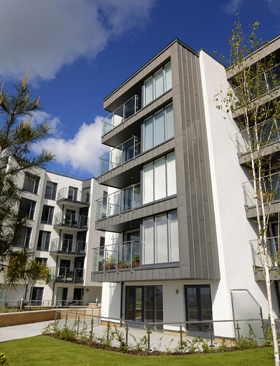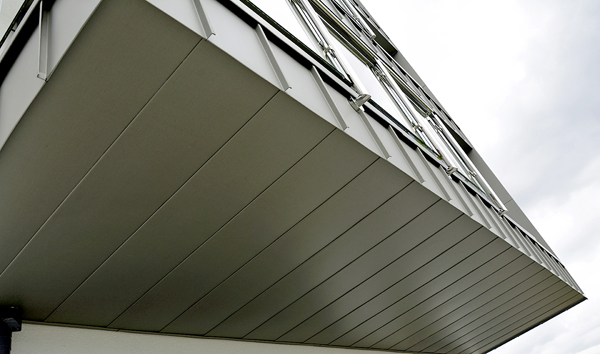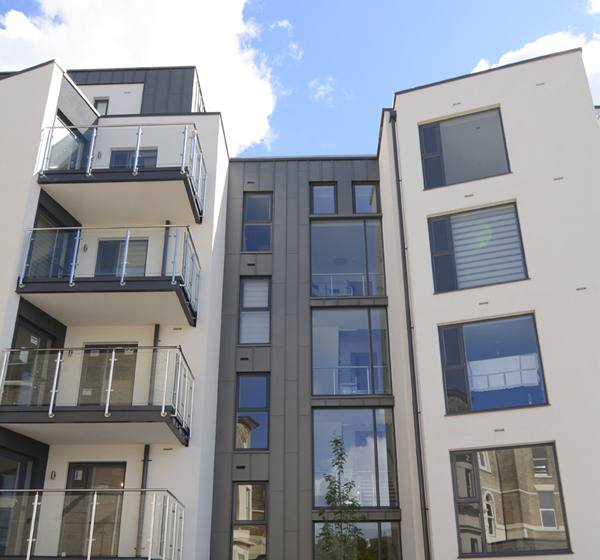This group of seafront apartments on the site of the former Bournemouth International Hotel is perched right on the cliff side. The modern aesthetic of white render and glazed balconies is offset with crisp elZinc zinc cladding supplied by SIG Zinc & Copper and installed by the specialist cladding team at ICEE. The project for Taylor Wimpey Southern Counties was designed post-planning and managed on site by architects WADP.
Using metal cladding on the coast
 Metal is an increasingly popular material for use in roofing and cladding in the UK, and this isn’t surprising when one sees the beautiful precise lines of the material, and understand the longevity and almost zero maintenance of metal products. The materials are also very popular in projects at coastal locations, although as we have written before, you need to know what you’re doing using metals in environments exposed to marine winds and salt spray.
Metal is an increasingly popular material for use in roofing and cladding in the UK, and this isn’t surprising when one sees the beautiful precise lines of the material, and understand the longevity and almost zero maintenance of metal products. The materials are also very popular in projects at coastal locations, although as we have written before, you need to know what you’re doing using metals in environments exposed to marine winds and salt spray.
“The biggest challenge on this site was the extreme marine environment,” says Jonathan Tolley, Architect at WADP, “This scheme really is exposed to the elements. It’s on top of a cliff; there is literally nothing between it and the sea.” Any materials had to survive that environment and be resistant to staining of any salts on the surface and self-cleansing.
This was a suitable challenge for SIG Zinc & Copper, who provide a wide range of metal products for roofing and cladding. The new development of luxury flats known as ‘Coast’, is the first use of elZinc Slate Advance in the UK. Specifically designed to be used in marine environments, elZinc Slate Advance has a protective coating which provides a barrier to salt damage and allows the salt to be washed off so it cannot eat into the metal.
Choosing the product and the team
Jonathan Tolley became involved in the project after planning and took it to completion as architect. As Taylor Wimpey had secured planning permission with a combination of white render and zinc cladding, one of Jonathan’s first tasks was to find the appropriate material. The design team looked at a wide range of products.
 Whilst the main driver was to maintain the look of zinc, the product also had to perform, and elZinc Advance promised the ability to survive this harsh environment over the long term with minimal maintenance. However, the choice of product was only part of the client’s decision. It was also essential that supplier and installer could provide the right level of technical support.
Whilst the main driver was to maintain the look of zinc, the product also had to perform, and elZinc Advance promised the ability to survive this harsh environment over the long term with minimal maintenance. However, the choice of product was only part of the client’s decision. It was also essential that supplier and installer could provide the right level of technical support.
“We met with a few representatives of different companies,” Jonathan Tolley explains. “SIG Zinc & Copper came across quite well, as did their accredited installers. But alongside being able to supply the material we wanted, what mattered most was the design support and detailing on offer. This was important because we knew it would be quite a complicated façade to get correct. Support during the production phase was therefore very important to us.”
The hands-on service
SIG Zinc & Copper don’t just supply the material; their service includes impartial product selection, design and detailing and full support throughout the contract. They and their accredited installers ICEE attended regular site meetings and made up example panels to demonstrate alternative details.
 Jonathan Tolley especially welcomed the on-site support from SIG Zinc & Copper and ICEE. “The process of being able to work up detailing on site – being prepared to do that rather than expect a finished drawing – was particularly helpful, especially with so many different junctions.”
Jonathan Tolley especially welcomed the on-site support from SIG Zinc & Copper and ICEE. “The process of being able to work up detailing on site – being prepared to do that rather than expect a finished drawing – was particularly helpful, especially with so many different junctions.”
“It was a challenge to detail the balconies, which are half glazed, half recessed with a continuous zinc section below,” says Jonathan. “The transition between elements is quite tricky, and because the façade is so exposed they must be watertight. The team produced a lot of experimental details for us which really helped us decide what would work with the glazing, render and other elements.”
Advice for architects using zinc
 Now that the project is completed, Jonathan Tolley is pleased with the cladding installation. “It looks really nice six months on – it will be interesting to see how it weathers over the winter. As a material zinc is quite tricky to install consistently, particularly the oil canning effect. But the result looks really good and is uniform across the scheme.”
Now that the project is completed, Jonathan Tolley is pleased with the cladding installation. “It looks really nice six months on – it will be interesting to see how it weathers over the winter. As a material zinc is quite tricky to install consistently, particularly the oil canning effect. But the result looks really good and is uniform across the scheme.”
The project went smoothly and WADP are now about to begin another, larger project with Taylor Wimpey. They will be using elZinc Slate Advance again, although in a less harsh environment. His advice for architects is simple – if you can use Zinc it’s an excellent material with many advantages.
“I wouldn’t have any hesitation in using it again. Zinc is a very good material, easy to manage, and in the light of recent events, it is also totally non-flammable. This is a consideration in a lot of people’s minds at the moment.”




